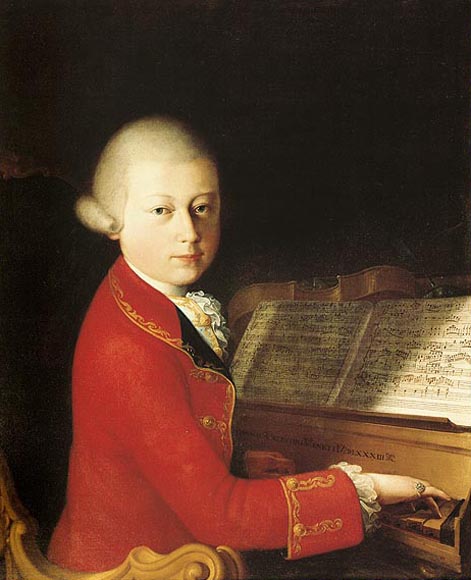Wolfgang Amadeus Mozart (1756-1791)
Born January 27, 1756 in Salzburg, Austria.
Died December 5, 1791 in Vienna.
Piano Concerto, K.V. 175 in D Major
Composed December 1773 in Salzburg
First Performance: with Mozart at the piano
Instrumentation: 2 oboes, bassoon ad libitum, 2 horns, 2 trumpets, timpani and strings.
The traditional number of piano concerti written by Mozart is 23. Or is it 27? You can buy a set of CD/MP3s right now labeled “the complete piano concertos” containing either number. This numbering is as misleading as the numbering of his symphonies. Mozart himself assigned no numbers to his works. In the case of the piano concerti his first four (KV 37, KV 39, KV 40, KV 41) – which are usually not included in the 23 – are arrangements for piano and orchestra of movements by leading gallant composers of the day such as Schobert and Raupach. These were most likely apprentice works given to him by his father. He took the concerti of the “English Bach,” Johann Christian, whose work Mozart discovered while living in London in 1764-65 as his model. Bach’s youngest son came to London in the 1760s and remained there for the rest of his life doing much to popularize the use of the new pianoforte including taking part in the first public concert involving the new instrument. The young Mozart spent much time with Bach who became an influence of Mozart’s developing style. In 1772 he wrote three additional concerti (KV 107) which were also arrangements of music by J.C. Bach and are also not included in the traditional numbering.
The piano concerto we hear today which Mozart referred to as his first concerto is his first independent piano concerto. You will find it referred to as either No. 5 or No. 1 – or just by the Köchel catalog number 175. He wrote it in December, 1773 in Salzburg. The limited piano range suggests that he wrote it for a particular instrument. Mozart was still feeling he way with this concerto. The scoring is unique among his concerti. There are many parts that he doubles unnecessarily including the entrance of the soloist which is doubled by the violins. He never does this again.
He reworked the concerto for a March 3, 1782 academy concert in Vienna. Mozart felt that the original contrapuntal sonata finale for the concerto would not suit Viennese popular taste. This was not the first time he substituted a concerto finale. The Violin Concerto KV 207 composed the same year also received a new finale. Besides re-orchestrating the wind parts, Mozart substituted the Rondo K. 382 for the finale which is described by [amazon text=Cuthbert Girdlestone&asin=0486212718] as “a series of insipid variations which are a poor substitute for the beautiful original.” We will hear the beautiful original today.
The concerto has three movements.
I. Allegro
II. Andante ma un poco adagio
III. Allegro
All three movements are in sonata form. Originally there was a single cadenza in the finale but in 1782 Mozart provided additional cadenzas for the first two movements.
The first movement is not written with the standard 8 measure periods. In the ritornello and transition there are five groups of three measures, the second subject and closing are groups of five, three, four and five measures.
Example 2. Second theme

Aside from the unusual phrase lengths the procedure is essentially the same as his later concerti. The solo exposition develops the ritornello phrases and modulates to the dominant. There is a development and the tutti presents both themes. There is a cadenza before a coda brings the movement to a close.
The second movement is quoted twice in a concert aria “Alcandro, lo confesso – No sò, d’onde viene” KV 294 written for Aloysia Weber – the older sister of his future wife. The aria was written in Mannheim for a performance at which he played KV 175.
Example 3. Second movement

Mozart borrows stock phrases during moments of intense expression from J.C. Bach.
Example 4.

There is a brief cadenza
The original finale was a sonata infused with polyphony that pre-shadowed later works such as the Piano Concerto KV. 459 and the finale of the Jupiter Symphony. The orchestral tutti that opens the finale presents no fewer than four themes before the entrance of the soloist. The first theme is treated canonically.
Example 5. Canonic first theme.

Example 6. Syncopated second theme

Example 7. Third theme

Example 8. Concluding fourth theme

The soloist dominates the development for the most part until the orchestra returns with the canonic theme. So, instead of the usual simple chordal introduction to the cadenza, there is a four part polyphony lead-in. Following the cadenza there is a very brief appearance of the fourth theme to bring the concerto to a close.
Resources
[amazon template=iframe image&asin=B000004166][amazon template=iframe image&asin=0769259294][amazon template=iframe image&asin=B002H0J0ZC][amazon template=iframe image&asin=B000004136]

